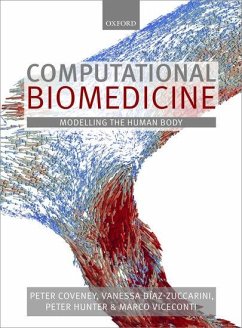Computational Biomedicine
Modelling the Human Body
Herausgeber: Coveney, Peter; Viceconti, Marco; Hunter, Peter; Diaz, Vanessa
Computational Biomedicine
Modelling the Human Body
Herausgeber: Coveney, Peter; Viceconti, Marco; Hunter, Peter; Diaz, Vanessa
- Broschiertes Buch
- Merkliste
- Auf die Merkliste
- Bewerten Bewerten
- Teilen
- Produkt teilen
- Produkterinnerung
- Produkterinnerung
Computational Biomedicine unifies the different strands of a broad-ranging subject to demonstrate the power of a tool that has the potential to revolutionise our understanding of the human body, and the therapeutic strategies available to maintain and protect it.
Andere Kunden interessierten sich auch für
![Nanotechnology for Cancer Therapy Nanotechnology for Cancer Therapy]() Nanotechnology for Cancer Therapy138,99 €
Nanotechnology for Cancer Therapy138,99 €![Oxford American Handbook of Pulmonary Medicine Oxford American Handbook of Pulmonary Medicine]() Kevin BrownOxford American Handbook of Pulmonary Medicine72,99 €
Kevin BrownOxford American Handbook of Pulmonary Medicine72,99 €![Adult Congenital Heart Disease Adult Congenital Heart Disease]() Adult Congenital Heart Disease76,99 €
Adult Congenital Heart Disease76,99 €![Colorectal Cancer Colorectal Cancer]() Colorectal Cancer48,99 €
Colorectal Cancer48,99 €![Healthcare Associated Infections Healthcare Associated Infections]() Healthcare Associated Infections75,99 €
Healthcare Associated Infections75,99 €![Inherited Cardiac Disease Inherited Cardiac Disease]() Inherited Cardiac Disease98,99 €
Inherited Cardiac Disease98,99 €![Oxford American Handbook of Surgery Oxford American Handbook of Surgery]() David L BergerOxford American Handbook of Surgery118,99 €
David L BergerOxford American Handbook of Surgery118,99 €-
-
-
Computational Biomedicine unifies the different strands of a broad-ranging subject to demonstrate the power of a tool that has the potential to revolutionise our understanding of the human body, and the therapeutic strategies available to maintain and protect it.
Produktdetails
- Produktdetails
- Verlag: Oxford University Press
- Seitenzahl: 296
- Erscheinungstermin: 12. August 2014
- Englisch
- Abmessung: 264mm x 195mm x 15mm
- Gewicht: 626g
- ISBN-13: 9780199658183
- ISBN-10: 0199658188
- Artikelnr.: 42379628
- Herstellerkennzeichnung
- Libri GmbH
- Europaallee 1
- 36244 Bad Hersfeld
- gpsr@libri.de
- Verlag: Oxford University Press
- Seitenzahl: 296
- Erscheinungstermin: 12. August 2014
- Englisch
- Abmessung: 264mm x 195mm x 15mm
- Gewicht: 626g
- ISBN-13: 9780199658183
- ISBN-10: 0199658188
- Artikelnr.: 42379628
- Herstellerkennzeichnung
- Libri GmbH
- Europaallee 1
- 36244 Bad Hersfeld
- gpsr@libri.de
Professor Peter Coveney, Centre for Computational Science, University College London Dr Vanessa Díaz-Zuccarini, Department of Mechanical Engineering, University College London Professor Peter Hunter, Auckland Bioengineering Institute, New Zealand Professor Marco Viceconti, Department of Mechanical Engineering , The University of Sheffield
* 1: Introduction
* 2: Molecular Foundations of Computational Bioscience
* 2.1 Introduction
* 2.2 Types of Omics Data
* 2.3 Databases and Data Sources
* 2.4 Management of Omics Data Types
* 2.5 Software Systems and Interoperability
* 2.6 Clinical Phenotypes, Security and Data Sharing
* 2.7 Conclusions
* 3: Understanding the Genotype-Phenotype Relationship
* 3.1 Introduction
* 3.2 Quantitative Genetics Theory
* 3.3 Systems Genetics
* 3.4 Implementing CGP Models
* 3.5 CGP Applications
* 3.6 Linking CGP Models to Data
* 3.7 Conclusions
* 4: Image Based Modelling
* 4.1 Introduction
* 4.2 Biomedical Imaging Techniques
* 4.3 Image Based Modelling
* 4.4 Medical Image Simulation
* 4.5 Statistical Atlases, Populational Imaging and Modelling
* 4.6 Open Source Image Modelling Tools
* 4.7 Conclusions
* 5: Modelling Cell Function
* 5.1 Introduction
* 5.2 General Cell Functions
* 5.3 Cell Fundamentals
* 5.4 Levels of Abstraction
* 5.5 Cell Simulation
* 5.6 Approaches to Modelling and Simulation
* 5.7 Simulation Tools
* 5.8 Example: An Agent Model in Skeletal Mechanobiology
* 5.9 Reproducible Modelling: Ordinary Differential Equations
* 5.10 Conclusions
* 6: Modelling Tissues and Organs
* 6.1 Introduction
* 6.2 Modelling Epithelia
* 6.3 Cardiac Modelling
* 6.4 Modelling the Gastro-Intestinal Tract
* 6.5 Modelling Kidney Function and Homeostasis
* 6.6 General Homeostasis and Blood Pressure Regulation
* 6.7 Conclusions
* 7: Multi-Scale Modelling
* 7.1 Introduction
* 7.2 Why Multi-Scale Modelling?
* 7.3 A Framework for Multi-Scale Modelling and Computing
* 7.4 Scale Bridging
* 7.5 Multi-Scale Computing
* 7.6 Example of a Multiscale Model: In-Stent Restenosis in Coronary
Arteries
* 7.7 Conclusions
* 8: Workflows: Principles, Tools and Clinical Applications
* 8.1 Introduction: What is a Workflow?
* 8.2 Computational Workflows
* 8.3 Workflow Implementations
* 8.4 Provenance
* 8.5 Examples of Scientific Workflows
* 8.6 Key Considerations
* 8.7 Conclusions
* 9: Distributed Biomedical Computing
* 9.1 Introduction
* 9.2 Parallel Applications
* 9.3 The Computational Ecosystem
* 9.4 Computing Beyond the Desktop
* 9.5 Simulations in a High Performance Computing Environment
* 9.6 Case Study 1: Calculating Drug Binding Affinities
* 9.7 Computational Infrastructures
* 9.8 Distributed Applications
* 9.9 Orchestrated Workflows from Distributed Applications
* 9.10 Case Study 2: Computational Investigations of Cranial
Haemodynamics
* 9.11 Conclusions
* 10: Managing Security and Privacy of Patient Data Sharing Platforms
* 10.1 Introduction
* 10.2 Legal Background
* 10.3 Brief Overview of Information Security Concepts
* 10.4 Common Data Sharing Requirements
* 10.5 The Data Sharing Lifecycle
* 10.6 Data Warehousing Architecture
* 10.7 Conclusions
* 11: Toward Clinical Deployment: Verification and Validation of Models
* 11.1 Introduction: Technology Assessment versus Health Assessment
* 11.2 Code and Model Verification
* 11.3 Sensitivity Analysis
* 11.4 Model Validation
* 11.5 Validation of Integrative Models
* 11.6 Clinical Accuracy
* 11.7 Efficacy, Risk and Cost-Benefit
* 11.8 Impact
* 11.9 Sustainability
* 11.10 Conclusions
* Appendix: Modelling Standards and Model Repositories
* A.1 Introduction
* A.2 Infrastructure for Computational Biomedicine
* A.3 Syntax, Semantics and Annotation of Models
* A.4 Markup Languages
* A.5 Model Repositories
* A.6 Conclusions
* 2: Molecular Foundations of Computational Bioscience
* 2.1 Introduction
* 2.2 Types of Omics Data
* 2.3 Databases and Data Sources
* 2.4 Management of Omics Data Types
* 2.5 Software Systems and Interoperability
* 2.6 Clinical Phenotypes, Security and Data Sharing
* 2.7 Conclusions
* 3: Understanding the Genotype-Phenotype Relationship
* 3.1 Introduction
* 3.2 Quantitative Genetics Theory
* 3.3 Systems Genetics
* 3.4 Implementing CGP Models
* 3.5 CGP Applications
* 3.6 Linking CGP Models to Data
* 3.7 Conclusions
* 4: Image Based Modelling
* 4.1 Introduction
* 4.2 Biomedical Imaging Techniques
* 4.3 Image Based Modelling
* 4.4 Medical Image Simulation
* 4.5 Statistical Atlases, Populational Imaging and Modelling
* 4.6 Open Source Image Modelling Tools
* 4.7 Conclusions
* 5: Modelling Cell Function
* 5.1 Introduction
* 5.2 General Cell Functions
* 5.3 Cell Fundamentals
* 5.4 Levels of Abstraction
* 5.5 Cell Simulation
* 5.6 Approaches to Modelling and Simulation
* 5.7 Simulation Tools
* 5.8 Example: An Agent Model in Skeletal Mechanobiology
* 5.9 Reproducible Modelling: Ordinary Differential Equations
* 5.10 Conclusions
* 6: Modelling Tissues and Organs
* 6.1 Introduction
* 6.2 Modelling Epithelia
* 6.3 Cardiac Modelling
* 6.4 Modelling the Gastro-Intestinal Tract
* 6.5 Modelling Kidney Function and Homeostasis
* 6.6 General Homeostasis and Blood Pressure Regulation
* 6.7 Conclusions
* 7: Multi-Scale Modelling
* 7.1 Introduction
* 7.2 Why Multi-Scale Modelling?
* 7.3 A Framework for Multi-Scale Modelling and Computing
* 7.4 Scale Bridging
* 7.5 Multi-Scale Computing
* 7.6 Example of a Multiscale Model: In-Stent Restenosis in Coronary
Arteries
* 7.7 Conclusions
* 8: Workflows: Principles, Tools and Clinical Applications
* 8.1 Introduction: What is a Workflow?
* 8.2 Computational Workflows
* 8.3 Workflow Implementations
* 8.4 Provenance
* 8.5 Examples of Scientific Workflows
* 8.6 Key Considerations
* 8.7 Conclusions
* 9: Distributed Biomedical Computing
* 9.1 Introduction
* 9.2 Parallel Applications
* 9.3 The Computational Ecosystem
* 9.4 Computing Beyond the Desktop
* 9.5 Simulations in a High Performance Computing Environment
* 9.6 Case Study 1: Calculating Drug Binding Affinities
* 9.7 Computational Infrastructures
* 9.8 Distributed Applications
* 9.9 Orchestrated Workflows from Distributed Applications
* 9.10 Case Study 2: Computational Investigations of Cranial
Haemodynamics
* 9.11 Conclusions
* 10: Managing Security and Privacy of Patient Data Sharing Platforms
* 10.1 Introduction
* 10.2 Legal Background
* 10.3 Brief Overview of Information Security Concepts
* 10.4 Common Data Sharing Requirements
* 10.5 The Data Sharing Lifecycle
* 10.6 Data Warehousing Architecture
* 10.7 Conclusions
* 11: Toward Clinical Deployment: Verification and Validation of Models
* 11.1 Introduction: Technology Assessment versus Health Assessment
* 11.2 Code and Model Verification
* 11.3 Sensitivity Analysis
* 11.4 Model Validation
* 11.5 Validation of Integrative Models
* 11.6 Clinical Accuracy
* 11.7 Efficacy, Risk and Cost-Benefit
* 11.8 Impact
* 11.9 Sustainability
* 11.10 Conclusions
* Appendix: Modelling Standards and Model Repositories
* A.1 Introduction
* A.2 Infrastructure for Computational Biomedicine
* A.3 Syntax, Semantics and Annotation of Models
* A.4 Markup Languages
* A.5 Model Repositories
* A.6 Conclusions
* 1: Introduction
* 2: Molecular Foundations of Computational Bioscience
* 2.1 Introduction
* 2.2 Types of Omics Data
* 2.3 Databases and Data Sources
* 2.4 Management of Omics Data Types
* 2.5 Software Systems and Interoperability
* 2.6 Clinical Phenotypes, Security and Data Sharing
* 2.7 Conclusions
* 3: Understanding the Genotype-Phenotype Relationship
* 3.1 Introduction
* 3.2 Quantitative Genetics Theory
* 3.3 Systems Genetics
* 3.4 Implementing CGP Models
* 3.5 CGP Applications
* 3.6 Linking CGP Models to Data
* 3.7 Conclusions
* 4: Image Based Modelling
* 4.1 Introduction
* 4.2 Biomedical Imaging Techniques
* 4.3 Image Based Modelling
* 4.4 Medical Image Simulation
* 4.5 Statistical Atlases, Populational Imaging and Modelling
* 4.6 Open Source Image Modelling Tools
* 4.7 Conclusions
* 5: Modelling Cell Function
* 5.1 Introduction
* 5.2 General Cell Functions
* 5.3 Cell Fundamentals
* 5.4 Levels of Abstraction
* 5.5 Cell Simulation
* 5.6 Approaches to Modelling and Simulation
* 5.7 Simulation Tools
* 5.8 Example: An Agent Model in Skeletal Mechanobiology
* 5.9 Reproducible Modelling: Ordinary Differential Equations
* 5.10 Conclusions
* 6: Modelling Tissues and Organs
* 6.1 Introduction
* 6.2 Modelling Epithelia
* 6.3 Cardiac Modelling
* 6.4 Modelling the Gastro-Intestinal Tract
* 6.5 Modelling Kidney Function and Homeostasis
* 6.6 General Homeostasis and Blood Pressure Regulation
* 6.7 Conclusions
* 7: Multi-Scale Modelling
* 7.1 Introduction
* 7.2 Why Multi-Scale Modelling?
* 7.3 A Framework for Multi-Scale Modelling and Computing
* 7.4 Scale Bridging
* 7.5 Multi-Scale Computing
* 7.6 Example of a Multiscale Model: In-Stent Restenosis in Coronary
Arteries
* 7.7 Conclusions
* 8: Workflows: Principles, Tools and Clinical Applications
* 8.1 Introduction: What is a Workflow?
* 8.2 Computational Workflows
* 8.3 Workflow Implementations
* 8.4 Provenance
* 8.5 Examples of Scientific Workflows
* 8.6 Key Considerations
* 8.7 Conclusions
* 9: Distributed Biomedical Computing
* 9.1 Introduction
* 9.2 Parallel Applications
* 9.3 The Computational Ecosystem
* 9.4 Computing Beyond the Desktop
* 9.5 Simulations in a High Performance Computing Environment
* 9.6 Case Study 1: Calculating Drug Binding Affinities
* 9.7 Computational Infrastructures
* 9.8 Distributed Applications
* 9.9 Orchestrated Workflows from Distributed Applications
* 9.10 Case Study 2: Computational Investigations of Cranial
Haemodynamics
* 9.11 Conclusions
* 10: Managing Security and Privacy of Patient Data Sharing Platforms
* 10.1 Introduction
* 10.2 Legal Background
* 10.3 Brief Overview of Information Security Concepts
* 10.4 Common Data Sharing Requirements
* 10.5 The Data Sharing Lifecycle
* 10.6 Data Warehousing Architecture
* 10.7 Conclusions
* 11: Toward Clinical Deployment: Verification and Validation of Models
* 11.1 Introduction: Technology Assessment versus Health Assessment
* 11.2 Code and Model Verification
* 11.3 Sensitivity Analysis
* 11.4 Model Validation
* 11.5 Validation of Integrative Models
* 11.6 Clinical Accuracy
* 11.7 Efficacy, Risk and Cost-Benefit
* 11.8 Impact
* 11.9 Sustainability
* 11.10 Conclusions
* Appendix: Modelling Standards and Model Repositories
* A.1 Introduction
* A.2 Infrastructure for Computational Biomedicine
* A.3 Syntax, Semantics and Annotation of Models
* A.4 Markup Languages
* A.5 Model Repositories
* A.6 Conclusions
* 2: Molecular Foundations of Computational Bioscience
* 2.1 Introduction
* 2.2 Types of Omics Data
* 2.3 Databases and Data Sources
* 2.4 Management of Omics Data Types
* 2.5 Software Systems and Interoperability
* 2.6 Clinical Phenotypes, Security and Data Sharing
* 2.7 Conclusions
* 3: Understanding the Genotype-Phenotype Relationship
* 3.1 Introduction
* 3.2 Quantitative Genetics Theory
* 3.3 Systems Genetics
* 3.4 Implementing CGP Models
* 3.5 CGP Applications
* 3.6 Linking CGP Models to Data
* 3.7 Conclusions
* 4: Image Based Modelling
* 4.1 Introduction
* 4.2 Biomedical Imaging Techniques
* 4.3 Image Based Modelling
* 4.4 Medical Image Simulation
* 4.5 Statistical Atlases, Populational Imaging and Modelling
* 4.6 Open Source Image Modelling Tools
* 4.7 Conclusions
* 5: Modelling Cell Function
* 5.1 Introduction
* 5.2 General Cell Functions
* 5.3 Cell Fundamentals
* 5.4 Levels of Abstraction
* 5.5 Cell Simulation
* 5.6 Approaches to Modelling and Simulation
* 5.7 Simulation Tools
* 5.8 Example: An Agent Model in Skeletal Mechanobiology
* 5.9 Reproducible Modelling: Ordinary Differential Equations
* 5.10 Conclusions
* 6: Modelling Tissues and Organs
* 6.1 Introduction
* 6.2 Modelling Epithelia
* 6.3 Cardiac Modelling
* 6.4 Modelling the Gastro-Intestinal Tract
* 6.5 Modelling Kidney Function and Homeostasis
* 6.6 General Homeostasis and Blood Pressure Regulation
* 6.7 Conclusions
* 7: Multi-Scale Modelling
* 7.1 Introduction
* 7.2 Why Multi-Scale Modelling?
* 7.3 A Framework for Multi-Scale Modelling and Computing
* 7.4 Scale Bridging
* 7.5 Multi-Scale Computing
* 7.6 Example of a Multiscale Model: In-Stent Restenosis in Coronary
Arteries
* 7.7 Conclusions
* 8: Workflows: Principles, Tools and Clinical Applications
* 8.1 Introduction: What is a Workflow?
* 8.2 Computational Workflows
* 8.3 Workflow Implementations
* 8.4 Provenance
* 8.5 Examples of Scientific Workflows
* 8.6 Key Considerations
* 8.7 Conclusions
* 9: Distributed Biomedical Computing
* 9.1 Introduction
* 9.2 Parallel Applications
* 9.3 The Computational Ecosystem
* 9.4 Computing Beyond the Desktop
* 9.5 Simulations in a High Performance Computing Environment
* 9.6 Case Study 1: Calculating Drug Binding Affinities
* 9.7 Computational Infrastructures
* 9.8 Distributed Applications
* 9.9 Orchestrated Workflows from Distributed Applications
* 9.10 Case Study 2: Computational Investigations of Cranial
Haemodynamics
* 9.11 Conclusions
* 10: Managing Security and Privacy of Patient Data Sharing Platforms
* 10.1 Introduction
* 10.2 Legal Background
* 10.3 Brief Overview of Information Security Concepts
* 10.4 Common Data Sharing Requirements
* 10.5 The Data Sharing Lifecycle
* 10.6 Data Warehousing Architecture
* 10.7 Conclusions
* 11: Toward Clinical Deployment: Verification and Validation of Models
* 11.1 Introduction: Technology Assessment versus Health Assessment
* 11.2 Code and Model Verification
* 11.3 Sensitivity Analysis
* 11.4 Model Validation
* 11.5 Validation of Integrative Models
* 11.6 Clinical Accuracy
* 11.7 Efficacy, Risk and Cost-Benefit
* 11.8 Impact
* 11.9 Sustainability
* 11.10 Conclusions
* Appendix: Modelling Standards and Model Repositories
* A.1 Introduction
* A.2 Infrastructure for Computational Biomedicine
* A.3 Syntax, Semantics and Annotation of Models
* A.4 Markup Languages
* A.5 Model Repositories
* A.6 Conclusions








